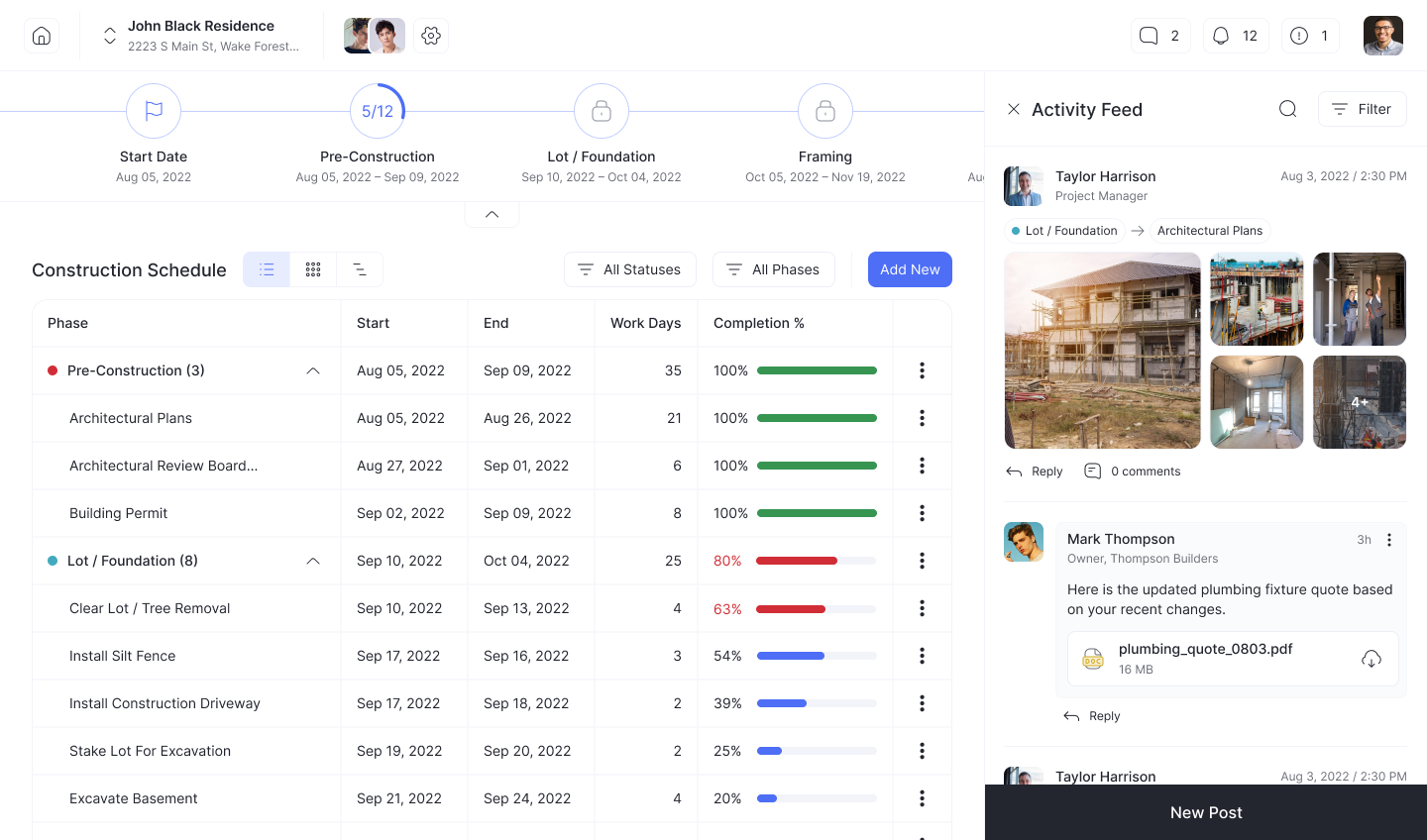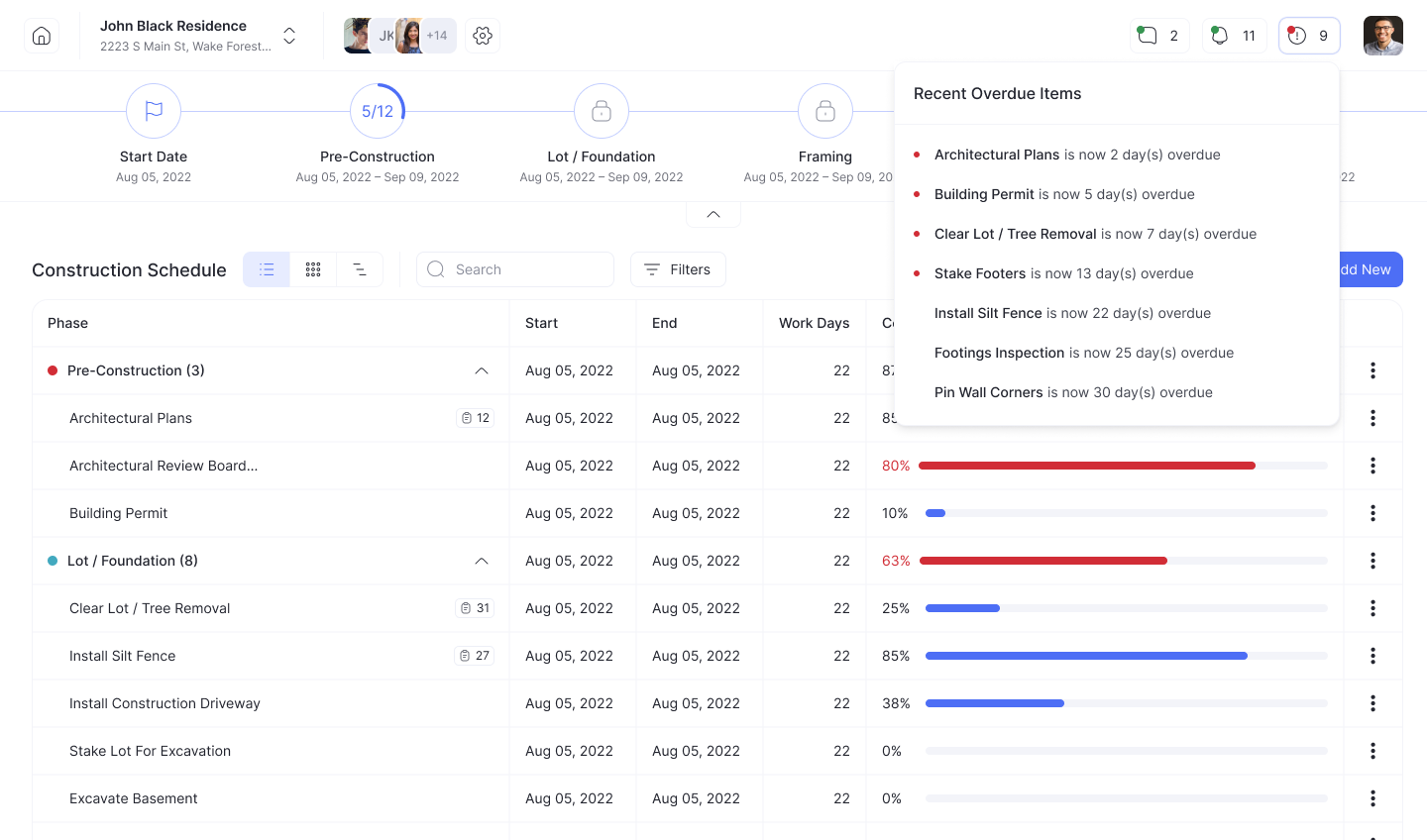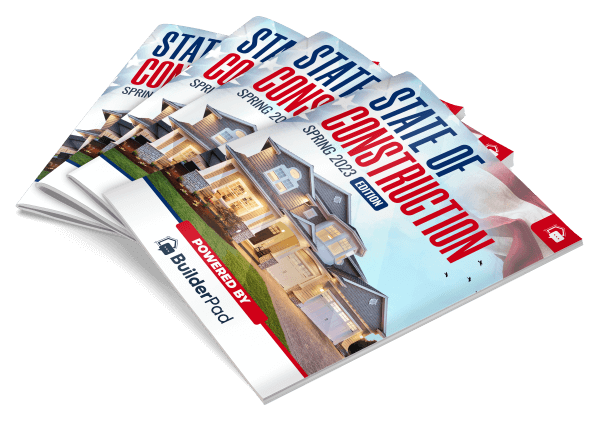In the dynamic realm of construction and remodeling, client feedback – positive or negative – is an invaluable asset.
While positive feedback boosts morale and builds trust, negative feedback or complaints provide opportunities for growth, learning, and enhancing client relations.
Here’s a guide to effectively navigating client feedback in the construction and remodeling sector, enriched with the capabilities of BuilderPad.
1. Listen Actively
Before diving into problem-solving, it’s vital to understand the client’s perspective. Active listening involves:
- Giving the client your undivided attention.
- Avoiding interruptions or making premature judgments.
- Asking open-ended questions to grasp the full scope of their concerns.
- Reflecting back their concerns to ensure clarity.
- Being patient, even if the feedback is intense or emotional.
BuilderPad’s communication channels can help log and track all client communications, ensuring that no concern goes unnoticed or unresolved.

2. Acknowledge and Empathize
Validation goes a long way. Recognize their feelings and concerns. Statements like, “I understand why you feel this way,” or “Thank you for bringing this to our attention,” can make clients feel heard and valued.
- Empathy can transform a confrontational scenario into a collaborative one.
- It’s not just about acknowledging the issue but genuinely understanding its impact on the client.
BuilderPad’s features ensure every client interaction, including complaints, is stored and referenced, fostering consistent and empathetic communication.

3. Document Everything
From the initial project blueprint to any changes in the design or materials, maintain thorough documentation. In case of complaints, these records can provide clarity, resolve misunderstandings, and offer tangible solutions.
- Regular documentation helps avoid “he said, she said” scenarios and serves as a neutral point of reference.
- It offers a clear trail of decisions, enhancing transparency and promoting trust.
- Photographic or video evidence of progress can be invaluable, capturing real-time project evolution and condition.
- Detailed documentation helps in ensuring that all parties involved — from contractors to subcontractors — are aligned and accountable for their roles.
- In cases where legal or contractual disputes arise, well-maintained documentation can be an essential safeguard, providing clarity and evidence.
With its comprehensive documentation tools, BuilderPad ensures that every project detail, change order, and communication is archived and easily accessible.
4. Analyze the Root Cause
Every complaint has an underlying cause. Is it a communication breakdown, a lapse in quality control, or perhaps an unforeseen external factor? Pinpointing the cause is the first step toward effective resolution.
- By addressing the root cause, you ensure the issue doesn’t repeat in future projects.
- It showcases to the client a commitment to improvement.
5. Offer Solutions, Not Excuses
Clients are looking for solutions, not reasons or excuses. While it’s essential to provide context, the primary focus should be on how you plan to rectify the situation.
- Solutions showcase professionalism and a proactive approach.
- Being solution-oriented fosters trust and confidence in the client.
- By addressing concerns directly, you convey a sense of responsibility and ownership of the project.
- It’s not just about rectifying the present issue; it’s about setting a precedent for how future concerns will be handled, ensuring that the client feels secure in continuing the project with you.
- Remember that every solution offered and successfully implemented can potentially turn a negative experience into a testimonial of your dedication and commitment.
Utilizing BuilderPad’s construction management tools, teams can quickly devise and implement action plans to address client concerns.

6. Involve the Client in the Solution
Make the client an active part of the resolution process. This could be through regular updates on how you’re addressing their concerns or seeking their input on proposed solutions.
- Clients feel valued when they’re part of the problem-solving journey.
- It reinforces the collaborative nature of the builder-client relationship.
BuilderPad’s integrated communication channels enable real-time updates, ensuring clients are always in the loop.
7. Follow Up
After implementing a solution, check back with the client. Ensure they’re satisfied with the outcome and ask for feedback on how you handled their complaint.
- Regular check-ins post-resolution further solidify trust.
- It provides an opportunity to ensure the client feels valued and heard.
With its client management tools, BuilderPad facilitates timely follow-ups, ensuring continuity in communication.
8. Implement Preventative Measures

Use feedback as a tool for continuous improvement. If a particular complaint surfaces repeatedly, it might indicate a systemic issue that needs addressing.
- Prevention is better than cure, especially in maintaining long-term client relationships.
- Proactively addressing potential pitfalls showcases foresight and responsibility.
9. Educate Your Team

Ensure that your entire team, from site supervisors to customer service reps, is equipped to handle client feedback.
- A well-informed team can address concerns promptly and effectively.
- Continuous training ensures your team is always aligned with best practices.
Create and organize training materials, ensuring the team has easy access to resources and best practices.
10. Celebrate Positive Feedback

While addressing negative feedback is essential, it’s equally important to celebrate and acknowledge positive comments.
- Positive reinforcement motivates teams to maintain high standards.
- It showcases to the client that their positive feedback is valued and not taken for granted.
Use BuilderPad’s team communication features to share and celebrate positive client feedback, boosting team morale.
Conclusion
In construction and remodeling, building structures and building strong client relationships go hand in hand. Leveraging the capabilities of platforms like BuilderPad can revolutionize the way professionals navigate and address client feedback, ensuring projects not only reach completion but excel in client satisfaction.
To sum up: Here is a comprehensive list of solutions to cope with the problem of construction contingencies discussed in the article:
- Set aside an adequate contingency fund: The article recommends 10-20% of total project costs to cover unexpected expenses. Determine the right percentage based on project complexity and risks.
- Closely monitor contingency use: Track what the contingency is being used for to identify problem areas. Require approvals for contingency spending.
- Update estimates frequently: As more details become available, update estimates to reduce surprises. Provide updated spending forecasts to stakeholders.
- Manage change orders diligently: Scrutinize change orders to ensure validity, check for alternative solutions, negotiate pricing, and minimize impact.
- Enforce contracts rigorously: Contracts should clearly define responsibilities and change order workflows to minimize disputes.
- Improve communication: Keep all project stakeholders updated on budget and schedule changes to manage expectations.
- Choose contractors carefully: Thoroughly vet contractors to reduce performance problems and unforeseen costs. Check references diligently.
- Watch market conditions: Monitor material and labor costs and availability. Have contingency plans for sourcing constrained resources.
- Refine estimating skills: Invest in training to improve cost forecasting capabilities. Learn from past project histories.
- Implement controls: Use project management systems and procedures to control scope and costs.
- Reduce customization: Limit project changes and avoid expensive custom elements if possible. Stick to proven designs.
- Allow time buffers: Build in extra time to absorb delays without increasing costs through crash schedules.
- Address risks proactively: Anticipate issues like permits, weather, staffing to minimize impacts. Have workarounds ready.
- Pursue alternatives: Look for less costly procurement and design options if budgets are tight (e.g. value engineering).







